Renewable & Non-Conventional Sources Of Energy | Science & Technology for UPSC CSE PDF Download
Renewable & Non-Conventional Sources Of Energy
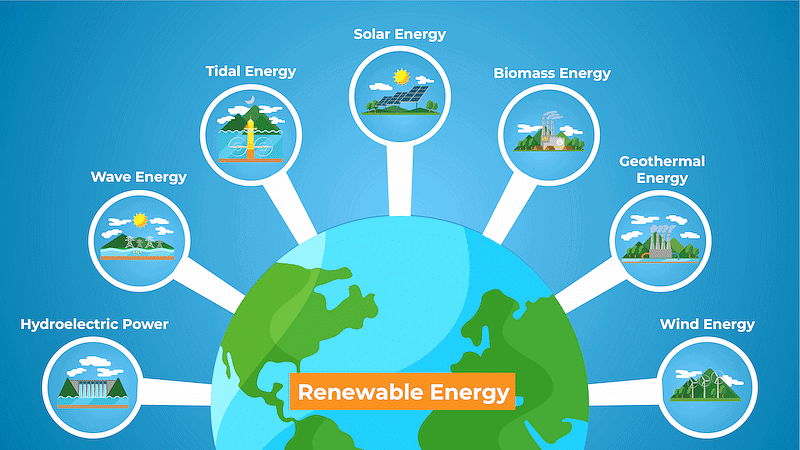
Following is a question based on Non Conventional Sources of Energy
With reference to two non-conventional energy sources called ‘coal bed methane’ and ‘shale gas’, consider the following ‘statements:
- Coal bed methane is the pure methane gas extracted from coal seams, while shale gas is a mixture of propane and butane only that can be extracted from fine-grained sedimentary rocks.
- In India abundant coal bed methane sources exist, but so far no shale gas sources have been found.
Which of the statements given above is/are correct?
- 1 only
- 2 only
- Both 1 and 2
- Neither 1 nor 2
CBM = Methane
Shale gas = Lot of Methane + Little Ethane, Propane, & Butane + very little carbon dioxide, nitrogen, and hydrogen sulfide.
Abundant shale reserves occur in India.
Biomass [Conventional Source]

- Biomass is a renewable energy resource derived from plant and animal waste.
- The energy from biomass (biomass conversion) is released on burning or breaking the chemical bonds of organic molecules formed during photosynthesis.
- Biomass fuels can be used directly or they can be transformed into more convenient form and then used.
Sources of biomass
- By-products from the timber industry, agricultural crops and their byproducts, raw material from the forest, major parts of household waste and wood.
- Solid Biomass fuels: Wood logs and wood pellets, charcoal, agricultural waste (stalks and other plant debris), animal waste (dung), aquatic plants (kelp and water hyacinths) urban waste (paper, cardboard and other combustible materials).
Conversion to gaseous and liquid biofuels
- Converting Biomass: We can turn biomass into liquids like ethanol and biodiesel by distilling it.
- Making Briquettes: Instead of using loose biomass, we squish it into briquettes, which are like compact blocks for easier handling.
- Replacing Coal: These briquettes can take the place of coal in old furnaces or machines called gasifiers, making them more useful.
- Gasification Magic: Gasifiers turn solid stuff like biomass into a handy gas called producer gas.
- Gaseous Biofuels: Biomass can also become gases like natural gas and wood gas, which are good alternatives too.
Uses of biomass
- In the developed world biomass is becoming important for applications such as combined heat and power generation.
- Biomass energy is gaining significance as a source of clean heat for domestic heating and community heating applications.
Advantages of biomass energy
- Carbon Neutrality: When we burn biomass, like wood or agricultural waste, it doesn't add extra carbon dioxide to the air. That's because the plants absorbed carbon dioxide while growing, and then release it when burned, balancing things out.
- Crucial Energy Source: Biomass is super important for energy, ranking just behind coal, oil, and natural gas worldwide.
- Renewable and Plentiful: It's renewable too, meaning we can keep using it without running out. Plus, there's loads of it around in various forms like firewood, leftover farm stuff, animal waste, and even city trash.
- Bio-Energy's Promise: Bio-energy, like biogas made from biomass, is predicted to be a major player in sustainable development worldwide.
Biogas plant
- The biogas plant consists of two components: a digester (or fermentation tank) and a gas holder.
- The gas holder cuts off air to the digester (anaerobiosis) and collects the gas generated.
- Any biodegradable (that which can be decomposed by bacteria) substance can be fermented anaerobically (in absence of oxygen) by methane-producing (methanogenic) bacteria.
- Cowdung or faeces are collected and put in a biogas digester or fermenter (a large vessel in which fermentation can take place).
- A series of chemical reactions occur in the presence of methanogenic bacteria (CH4 generating bacteria) leading to the production of CH4 and CO2.
Petro crops (Plants)
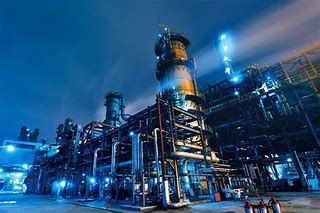
- Recent researches suggest that hydrocarbon producing plants can become alternative energy sources, which can be inexhaustible and ideal for liquid fuel.
- These plants called petroplants/petrocrops can be grown on land which are unfit for agriculture and not covered with forests. Jatropa curcas is an important petro plant.
- Biocrude can be obtained by tapping the latex of Jatropa curcas.
- Biocrude is a complex mixture of liquids, terpenoids, triglycerides, phytosterols waxes, and other modified isoprenoid compounds.
- Hydro cracking of biocrude can convert it into several useful products like gasoline (automobile fuel), gas oil and kerosene.
- Some potential Petro-crop species belong to family Asclepiadaceae and Euphorbiaceae.
Geothermal Energy
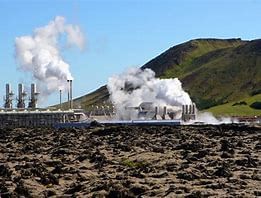
- Geothermal energy is natural heat from the interior of the earth that can be used to generate electricity as well as to heat up buildings.
- The core of the earth is very hot and it is possible to make use of this geothermal energy.
- These are areas where there are volcanoes, hot springs, and geysers, and methane under the water in the oceans and seas.
- In some countries, such as in the USA water is pumped from underground hot water deposits and used for heating of houses.
- Geothermal resource falls into three major categories: i) Geopressurized zones, ii) hot-rock zones and iii) Hydrothermal convection zones. Of these three only the first is currently being exploited on a commercial basis.
Geothermal energy in India
- In India, Northwestern Himalayas and the western coast are considered geothermal areas.
- The Geological Survey of India has already identified more than 350 hot spring sites, which can be explored as areas to tap geothermal energy.
- The Puga valley in the Ladakh region has the most promising geothermal field.
Environmental impact of geothermal energy
- Geothermal energy can pose several environmental problems which includes on-site noise, emissions of gas and disturbance at drilling sites.
- The steam contains hydrogen sulphide gas, which has the odour of rotten eggs, and cause air pollution.
- The minerals in the steam are also toxic to fish and they are corrosive to pipes, and equipment, requiring constant maintenance.
Hydrogen Energy
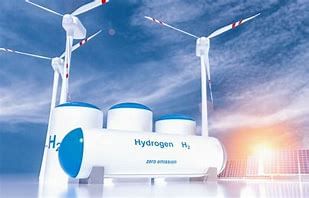
- Hydrogen: Fuel of the Future: Many scientists see hydrogen gas as the future's primary fuel.
- Clean Burning: When hydrogen burns, it combines with oxygen to make water vapor, which doesn't pollute. In fuel cells, hydrogen directly converts to electricity.
Environmental Benefits: Widely using hydrogen could significantly cut air pollution and the risk of global warming because it doesn't emit CO2.
Production Challenges: While hydrogen is clean, getting lots of pure hydrogen for business use is tough. It's usually mixed with other stuff like oxygen, carbon, or nitrogen, and separating it takes a ton of energy and money.
Algae Solution: Scientists are exploring ways to produce hydrogen from algae in big, controlled setups. They're even trying to tweak photosynthesis so that algae can make hydrogen.
Potential for Versatile Use: If we can make technologies like fuel cells cheaper, hydrogen could be a game-changer for everything from lighting to transportation, offering a clean, affordable energy alternative.
Fuel Cell Technology
- Fuel cells are highly efficient power-generating systems that produce electricity by combining fuel (hydrogen) and oxygen in an electrochemical reaction.
- Fuel cells are electrochemical devices that convert the chemical energy of a fuel directly and very efficiently into electricity (DC) and heat, thus doing away with combustion.
- Hydrogen and phosphoric acid are the most common type of fuel cells, although fuel cells that run on methanol, ethanol, and natural gas are also available.
- The most suitable fuel for such cells is hydrogen or a mixture of compounds containing hydrogen.
- A fuel cell consists of an electrolyte sandwiched between two electrodes. Oxygen passes over one electrode and hydrogen over the other, and they react electrochemically to generate electricity, water, and heat.
- Though rapid progress has been made; high initial cost is still the biggest hurdle in the widespread commercialization of fuel cells.
- The rapidly depleting fossil fuel sources of energy and escalating demand of energy have made it necessary to look for alternative sources of energy that are known as renewable or inexhaustible. We can define inexhaustible energy resources as ‘those resources which can be harnessed without depletion’. Most of these resources are free from pollution and some of them can be used at all places. These renewable energy resources are also known as non-conventional or inexhaustible or alternate energy sources. These energy sources are solar, flowing water, wind, hydrogen and geothermal. We get renewable solar energy directly from the sun and indirectly from moving water, wind and biomass. Like fossil fuels and nuclear power, each of these alternatives renewable sources of energy has their own advantages and disadvantages. We are going to discuss some of them in detail.
Solar Energy
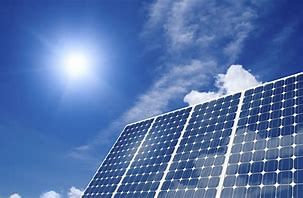
- Direct solar energy can be used as heat, light, and electricity through the use of solar cells.
- Direct use of solar energy can be used through various devices broadly directed into three types of systems a) passive, b) active c) photovoltaic.
Passive solar energy
- As you know some of the earliest uses of solar energy were passive in nature such as to evaporate sea water for producing salt and to dry food and clothes.
- In fact solar energy is still being used for these purposes. The more recent passive uses of solar energy is for cooking, heating, cooling and for the day lighting of homes and buildings.
Active use of solar energy
- Active solar heating and cooling systems rely on solar collectors which are usually mounted on roofs.
- Such systems also requires pumps and motors to move the fluids or blow air by fan in order to deliver the captured heat.
- A number of different active solar heating systems are available. The main application of these systems is to provide hot water, primarily for domestic use.
Solar cells or photovoltaic technology
- Solar energy can be converted directly into electrical energy (direct current, DC) by photovoltaic (PV) cells commonly called solar cells.
- Photovoltaic cells are made of silicon and other materials. When sunlight strikes the silicon atoms it causes electrons to eject. This principle is called as ‘photoelectric effect’.
- A typical solar cell is a transparent wafer that contains a very thin semiconductor.
- Sunlight energizes and causes electrons in the semiconductor to flow, creating an electrical current.
With reference to technologies for solar power production, consider the following statements:
- ‘Photovoltaics’ is a technology that generates electricity by direct conversion of light into electricity, while ‘Solar Thermal’ is a technology that utilizes the Sun’s rays to generate heat which is further used in electricity generation process.
- Photovoltaics generates Alternating Current (AC), while Solar Thermal generates Direct Current (DC).
- India has manufacturing base for Solar Thermal technology, but not for Photovoltaics.
Which of the statements given above is / are correct?
- 1 only
- 2 and 3 only
- 1, 2 and 3
- None
Explanation:
Photoelectric effect = When light strikes on a material, electrons are dislodged [photons dislodge electrons].
Photovoltaic = The dislodged electrons if channeled through a conductor will create electric current (voltage Or potential difference) = Solar Panels. [Electric current is nothing but movement of electrons from high potential to low potential area (more electrons to less electrons region)]
Solar thermal = converting light into heat = solar cooker, solar water heater.
Photovoltaics generate direct current (DC). [Rotating = AC, Stationary = DC. Electric generator, wind turbine generate AC while solar panels generate DC]
Solar thermal is mostly used for water heating purposes. Electricity can be generated by using hot water steam to rotate turbine = AC current.
In India both solar panels and solar cookers are manufactured. [Remember Indian – USA WTO ‘domestic content’ dispute?]
Answer: a) 1 only
Tidal energy
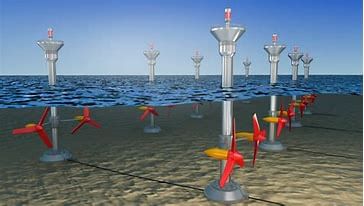
- Tidal power projects attempt to harness the energy of tides as they flow in and out.
- The main criteria for a tidal power generation site are that the mean tidal range must be greater than 5 metres.
- The tidal power is harnessed by building a dam across the entrance to a bay or estuary creating a reservoir.
- As the tide rises, water is initially prevented from entering the bay. Then when tides are high and water is sufficient to run the turbines, the dam is opened and water flows through it into the reservoir (the bay), turning the blades of turbines and generating electricity.
- Again when the reservoir (the bay) is filled, the dam is closed, stopping the flow and holding the water in reservoir when the tide falls (ebb tide), the water level in the reservoir is higher than that in the ocean.
- The dam is then opened to run the turbines (which are reversible), electricity is produced as the water is let out of the reservoir.
- The dams built to harness the tidal power adversely affect the vegetation and wildlife.
Hydropower Energy

- Hydroelectric power uses the kinetic energy of moving water to make electricity.
- Generation of electricity by using the force of falling water is called hydroelectricity or hydel power. It is cheaper than thermal or nuclear power.
- Dams are built to store water at a higher level; which is made to fall to rotate turbines that generate electricity.
- One of the greatest advantages of hydropower is that once the dam is built and turbines become operative, it is relatively cheap and clean source of energy.
- Hydropower also has some disadvantages, building of dam seriously disturbs and damages the natural habitats and some of them are lost forever.
Ministry of New and Renewable Energy (MNRE)
- The ministry was established as the Ministry of Non-Conventional Energy Sources in 1992. It adopted its current name in October 2006.
- The Ministry is mainly responsible for
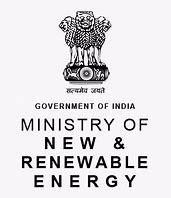
- research and development,
- intellectual property protection, and
- international cooperation, promotion, and coordination in renewable energy sources such as wind power, small hydro, biogas, and solar power.
Aim
- To develop and deploy new and renewable energy for supplementing the energy requirements of India.
Mission
- Bring in Energy Security;
- Increase the share of clean power;
- Increase Energy Availability and Access;
- Improve Energy Affordability; and
- Maximise Energy Equity.
Initiatives
- Jawaharlal Nehru National Solar Mission (JNNSM)
- Remote Village Lighting Programme
- National Biogas and Manure Management Programme (NBMMP)
- Solar Lantern Programme LALA
- Solar thermal energy Demonstration Programme
- National Biomass Cookstoves Initiative (NBCI)[8]
- National Offshore Wind Energy Authority
Key functional area
- Indian Renewable Energy Development Agency (IREDA)
- Integrated Rural Energy Programme (IREP);
- Commission for Additional Sources of Energy (CASE);
Jawaharlal Nehru National Solar Mission (JNNSM)
- Also known as the National Solar Mission
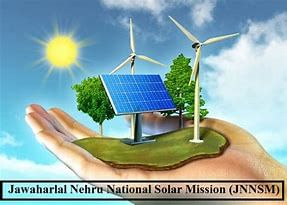
Objective
- To establish India as a global leader in solar energy, by creating the policy conditions for its diffusion across the country as quickly as possible.
- To promote ecologically sustainable growth while addressing India’s energy security challenges.
- Major contribution by India to the global effort to meet the challenges of climate change.
- One of the several initiatives that are part of National Action Plan on Climate Change.
- The program was inaugurated in 2010.
- Initial target was 20GW by 2022 and it was increased to 100 GW in 2015 Union budget.
- Long term goal: Global leader in solar energy; maximum in energy production.
- Immediate goal: Setting up an enabling environment for solar technology penetration in the country.
Targets are set for three phases
- First phase 2010-13
- Second phase 2013–17
- Third Phase 2017–22
- At each stage progress will be reviewed and roadmap for future targets will be adopted.
- Total target of 100,000 MW by 2022.
- MNRE has proposed to achieve it through 40,000 MW through Rooftop Solar Projects and 60,000 MW through Large and Medium Scale solar projects.
Domestic content controversy
- Solar Mission Guidelines: India's solar mission set rules for using domestically manufactured cells and modules for photovoltaic (PV) projects using crystalline silicon, which make up more than 60% of the total system costs.
- Domestic Content Requirement: For solar thermal projects, guidelines mandated that 30% of the project must have domestic content.
- Controversy Erupts: A heated debate ensued between power project developers and solar PV equipment manufacturers.
- Developer Preference: Developers prefer sourcing modules from the global market for competitive pricing, better quality, reliable delivery, and access to the latest technologies.
- Manufacturer Stance: Manufacturers advocate for a controlled environment to push developers to buy modules from a limited group of Indian manufacturers. They want to avoid competition with global players and are urging the government to support the growth of the local industry.
- International Dispute: The US Trade Representative lodged a complaint at the World Trade Organization, alleging that India's domestic content requirements unfairly discriminate against US exports.
Indian Renewable Energy Development Agency (IREDA)
- IREDA is a Mini Ratna (Category – I) Government of India Enterprise.
- It is under the administrative control of MNRE.
- IREDA is Public Limited Government Company established as a Non-Banking Financial Institution in 1987 engaged in promoting, developing and extending financial assistance for setting up projects relating to new and renewable sources of energy and energy efficiency/conservation with the motto: “Energy For Ever”.
Objectives
- To give financial support to specific projects and schemes for generating electricity and / or energy through new and renewable sources and conserving energy through energy efficiency.
- To increase IREDA’s share in the renewable energy sector by way of innovative financing.
|
90 videos|490 docs|209 tests
|
FAQs on Renewable & Non-Conventional Sources Of Energy - Science & Technology for UPSC CSE
| 1. What is the significance of the Ministry of New and Renewable Energy (MNRE)? |  |
| 2. How does the Jawaharlal Nehru National Solar Mission (JNNSM) contribute to renewable energy in India? |  |
| 3. What are some examples of non-conventional sources of energy mentioned in the article? |  |
| 4. How does biomass contribute to renewable energy production? |  |
| 5. What role do petro crops play in the renewable energy sector? |  |





















